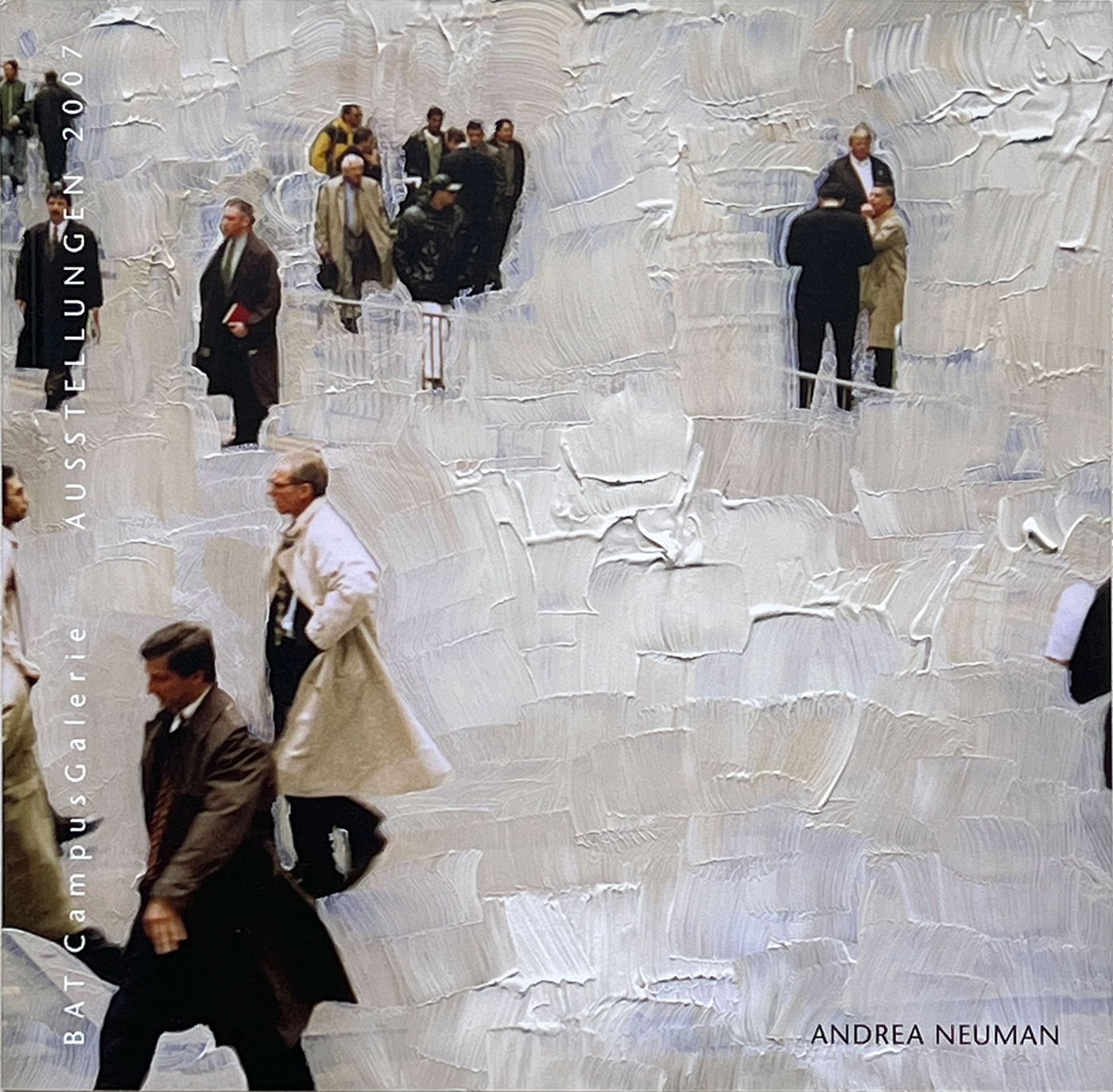Ingrid Pfeiffer
Andrea Neuman
Zwei Menschen gehen im Abstand von wenigen Metern mit großen eiligen Schritten aneinander vorbei. Sie scheinen Blickkontakt zu haben, doch ihre Gesichter kann man kaum erkennen. Nur ihre zum Ausschreiten erhobenen Füße sind in einer geraden Linie miteinander verbunden.
Was unterscheidet Künstler von anderen Menschen? Ihre Fähigkeit, uns Unbewusstes vor Augen zu führen, Verdrängtes, Vergessenes und unterschwellig Vorhandenes − die inneren Strukturen der Realität. Wie mit einem unsichtbaren Koordinatensystem verbindet Andrea Neuman die vereinzelten Individuen aus ihrer meist urbanen Welt: Bilder aus New York, Berlin, aber auch Dresden oder dem Bodensee bilden das vielfältige Repertoire für ihre Arbeiten mit übermalten Fotografien. Dabei geht es der Künstlerin immer um den Menschen – im Raum, in der Architektur oder überhaupt im Leben, um sein Schicksal als Einzelwesen, das in der Masse untergeht oder sich gegen sie behauptet. In ihren ebenso präzisen wie sinnlichen Arbeiten werden die Konturen der fotografierten Menschen und Orte gegen bewegte Farbflächen gesetzt und neu gedeutet, denn „Farbe ist Gefühl“ sagt Andrea Neuman und mischt aus unterschiedlichsten Pigmenten mit Ölfarbe jene Töne zusammen, die genau die Stimmung oder das Lebensgefühl erzeugen, das sie jeweils anstrebt. „Farbräume als existenzielle Erfahrungsräume“ sagt Neuman auch und lässt den Betrachter teilhaben an dieser besonderen Erfahrung, die jedes Motiv vermittelt.
Genauso wichtig wie die Farbe ist die Oberfläche der Bilder, oft gerastert, mit Netzstrukturen oder bewegten Pinselstrichen, die wirken, als würde der Wind über eine Wasseroberfläche streichen. Farbe wird hier zum Material, zum Relief, das die Handschrift des Künstlers transportiert und jedem Bild eigene Individualität verleiht. Die Flächigkeit der Fotografie, ihre scheinbare Nähe zur Realität, erhält durch die dick aufgetragene Ölfarbe ein Gegengewicht, so dass sich inhaltliche und formale Bildebenen vermischen, mit- und gegeneinander wirken und damit Spannung aufbauen.
Mit diesem komplexen Wechselspiel der beiden Medien Fotografie und Malerei, Komposition und Struktur, Körper und Fläche, werden aber auch komplexe Inhalte transportiert: So kommt Ironie zum Vorschein, wenn Andrea Neuman eine Serie „Das große Glück der klaren Verhältnisse“ nennt, denn bleischwer liegt die graue Farbe über der Serie, mal als Himmel über der Menschenmasse, mal als Boden wie schmutziger Schnee. Man fragt sich, wohin diese Menschen wollen, was sie antreibt und bewegt – sind sie denn noch eigenständige Individuen? Worin besteht ihr „Glück“ oder hat sich gerade dieses endgültig verabschiedet bei so viel Verlust an Individualität? Eine große Einsamkeit lässt sich hier ahnen, denn jeder steht für sich alleine, selbst in der eng zusammengedrängten Menge. Andrea Neuman interessiert sich für soziologische Phänomene ebenso wie für Philosophie. Immer wieder kreisen ihre Themen um Sinn und Dasein, um Erinnern und auch um das Phänomen der Zeit. Gerade in ihren bevorzugten urbanen Szenen – Börsenbroker von der Wall Street, Menschen auf öffentlichen Plätzen, oft im Laufschritt ihren Weg suchend – geht es um Gegenwart und Zukunft, um Vergänglichkeit und die verschiedenen Seiten des Phänomens der Serie und der Wiederholung. Die Sehnsucht des Menschen nach Sinn, nach Aufgehobensein in der Welt, drückt sich in vielen Werken aus.
Mehr und mehr hat Andrea Neuman in den letzten Jahren ihr charakteristisches Repertoire aus übermalten Fotografien erweitert und verändert. Während sie früher oft stundenlang auf ein geeignetes Fotomotiv gewartet hat, wird jetzt der Raum durch das aktive Gehen erlebt und durchmessen. „Gehen ist Denken“ schreibt die Künstlerin in ihren Notizen. Sie hat dafür eine Digitalkamera über Stunden auf den Boden gerichtet und flüchtige Momente von Durchwandern und eigener Lebenszeit festgehalten. Denn die Reise gilt als Metapher für das Leben selbst.
Durch das Aneinanderreihen vieler Momentaufnahmen entsteht der Eindruck von Filmstills: der bewegte Körper wird fließend, verliert seine Kontur, wird zum Schatten, während die unbelebte Umgebung – das Bodenraster aus Metall, typisch für den Stadtteil Soho in New York oder die Pflastersteine einer deutschen Kleinstadt – deutlich zu erkennen sind und ihre Festigkeit behalten. In diesen Arbeiten wird die Künstlerin abstrakter als zuvor, gibt erstmals die fixierende Festigkeit der Ölfarbe auf zugunsten der mehr dem Schein als der Wirklichkeit verpflichteten Fotografie.
Großformatige Wandinstallationen gehören zu Neumans aktuellen Arbeiten, in denen die unterschiedlichen Formate ein sensibles Mit- und Gegeneinander von Motiven, Strukturen und Farben erzeugen, sich gegenseitig steigern und so den Bildraum zum Erlebnisraum machen. Eine umfassende Serie von 750 Digitalfotografien, installativ auf eine 6 Meter lange Wand gesetzt, schafft einen eindrucksvollen strukturierten Bildraum, dessen malerische Gegenwelt ein großes weißes Quadrat mit bewegter Oberfläche darstellt: Es erinnert an die monochrome Malerei eines Robert Ryman, der sagte „The basic problem is what to do with paint“. Auch bei Andrea Neuman geht es immer auch um „paint“ und nicht nur um „color“, denn die erwähnte bewegte Oberfläche ihrer übermalten Fotografien und Bilder trägt wesentlich zur komplexen Gesamtwirkung dieser ungewöhnlichen Arbeiten bei.

